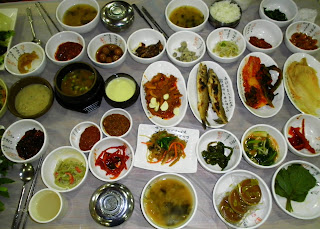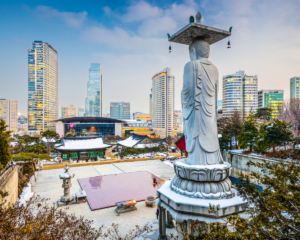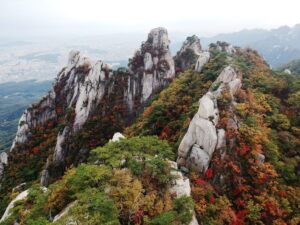May is one of the best times to visit Korea. The weather is delightful, the countryside is green, and the people seem to be happier this time of year. There’s always something going on and the festivals around the country are seemingly innumerable. With Children’s Day and Buddah’s Birthday being national holidays, I decided to take advantage of my time off to do a little sightseeing of my own and head to Gyeongju: the ancient capital of Korea.
Gyeongju is located on the southeastern coast of the country and is easily accessible by train, car, or bus. It is also a city serviced by the free shuttle promotion for foreigners sponsored by Visit Korea Year. I can’t pass up free stuff, especially when it involves travel, so I applied for a ticket a few weeks previous to my trip and was fortunate to be chosen at random for a spot on the luxury bus. The four and a half hour ride didn’t seem long at all, what with the super comfy reclining seats and the lush scenery of the mountains dotted with the pink of the azaleas that outlined our route.
One of the great things about Gyeongju, in particular the downtown vicinity, is that it is relatively small in area and is fairly walkable. It didn’t take long to find Nahbi Guesthouse, the hostel where I’d be staying for the weekend. TJ, the owner, and Peter, his assistant, were hospitable from the start and after setting my things down in one of the dorms, they pointed out all of the sightseeing spots they recommended on a map of the city. Not wanting to waste time, I rented a bike from the guesthouse and set out to see the highlights of the central downtown area.
Some of the first things a visitor notices in Gyeongju are the immense tumuli, hill-like structures that are speckled throughout the area. Similar to the pyramids of Egypt, these mounds of earth are actually burial tombs of the ancient kings of the Shilla dynasty, arguably the most influential of the three kingdoms of ancient Korea. While they are quite numerous, they are most concentrated at Tumuli Park. This park houses 23 tombs in addition to some beautiful ponds and wooded areas. There is even one tomb which has been renovated so that visitors can see what the tomb would have looked like on the inside: a wooden coffin which held the king’s body, in addition to valuable objects, sat at the bottom of the tomb which was then covered by layers of large rocks in a dome-like fashion. The structure was topped with a thick layer of clay, which was then covered with dirt and grass. Inside the model tomb, there are also artifacts such as pottery and jewelry that were commonly placed in the tomb alongside the king or member of the royal family.
 Tumuli Park is beautiful as it is historical.
Tumuli Park is beautiful as it is historical.
 Spring flowers outline walking paths in Wolseong Park in the center of Gyeongju.
Spring flowers outline walking paths in Wolseong Park in the center of Gyeongju.
Anapji Pond was once a playground of Shilla royalty. Nowadays, it’s a picturesque tourist spot popular with both Korean and foreign visitors alike.
After befriending a few fellow Americans the night before, we decided to head out together to visit Bulguksa Temple and Seokguram Grotto, the cultural jewels of Gyeongju. We caught a bus to Bulguksa only to be herded onto the temple grounds with hundreds of other tourists. It was a free-for-all but fortunately we were able to eventually get away from the crowds as people dispersed throughout the complex. We passed pagodas, wandered through bamboo groves, and added prayer rocks to an impressive stony garden near one of the temples. Bulguksa was all very beautiful and the architecture, said to be the best existing example of Shilla architecture, was a visual treat. Still, we were anxious to get up to Seokguram. Opting out of the hour long hike, we hailed a cab up the mountain and soon found ourselves following a woody walkway. Just as we were enjoying the peaceful stroll amidst the hanging lanterns displayed for Buddha’s Birthday, we ended up at the tail of the line of hundreds to see the grotto.
Camera-toting tourists scrambled throughout the temple grounds during our visit to Bulguksa; nevertheless, the temple exuded spirituality.
 Lanterns decorated Bulguksa and Seokguram in preparation for Buddah’s Birthday.
Lanterns decorated Bulguksa and Seokguram in preparation for Buddah’s Birthday.
After we got back into town, we enjoyed a hearty lunch of ssambap, a famous Gyeongju dish. Or should I say dishes. Like 30 of them. Ranging from marinated mushrooms to beanpaste stew to fermented stingray (yuk!) we were able to try many different vegetables and meats that we rolled up in lettuce leaves with various sauces. It was, with a few exceptions, delicious and after having our desert of Gyeongju bbang (sweet bread stuffed with red bean), we headed back to the hostel lethargically for a nap. After a final rooftop party, I packed my bags and prepared for checkout in the morning.
We were able to get a little taste of everything at a ssambap restaurant. A typical spread includes meat, vegetables, soup, and sauces.
Before leaving, I visited the Gyeongju National Museum to learn more about Korea’s history. There were halls of artifacts, like those found at the excavation of Anapji Pond, and all of the exhibits offered a lot of interesting information about various aspects of Korean life throughout the years; it was the perfect way to end my adventure into the ancient capital. I wasn’t quite ready to head back into the modernity and fast-pace of Seoul; my little getaway to Gyeongju had provided an interesting glimpse into what Korea was like thousands of years ago and had enthralled me with its old-world allure. But, the bus wasn’t stopping, so as I dozed off as the sun set, back to the future I went.





